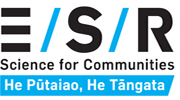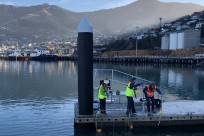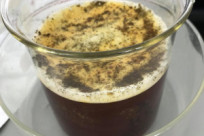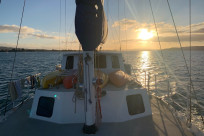What are microplastics?
Microplastics are pieces of plastic 0.1 - 5 mm in size. There are two types: primary and secondary microplastics. Primary microplastics are the plastics that are made for purpose, for example plastics used in industrial processes, in personal and household cleaning products, glitter, or nurdles – the tiny plastic pellets used to make virtually anything that is plastic. Secondary microplastics are the broken-down pieces of larger plastic items such as food packaging or car lights. There is estimated to be more than 15 trillion pieces of microplastic debris in the world’s oceans, 80% of which originate from land-based activities. Microplastics continue to breakdown over time, eventually turning into tinier particles known as nanoplastics, which may be even harder to extract from the environment.

Lyttleton Port in Christchurch where marine plastics research has been carried out.
Why are microplastics a problem?
International research has found microplastics in every environment, ecosystem and species so far tested, including in some of the most remote and uninhabited places on earth. Microplastic contamination has been found both in the seafood we eat and in our drinking water supplies. And if it’s not already there, it will be settling onto your plate from the air around us.
It's important to understand the sources and routes of microplastic contamination into different environments, and how they interact with the environment’s organisms, to fully understand the risks they present.
The threats posed by plastic pollution are similar to climate change. Like climate change, plastic pollution is occurring at a global scale, is transboundary and threatens ecosystem function and resilience, food security, human health and wellbeing. With its impacts affecting economies around the world, it is also inextricably linked with climate change - from the extraction of fossil fuels for plastic production to the role atmospheric microplastic particles play in the reflection and trapping of heat.
-
What does ESR do?
Our scientists are part of a national research programme called Aotearoa Impacts and Mitigation of Microplastics (AIM²). The project is the first comprehensive investigation of the impact of microplastics on Aotearoa New Zealand and includes scientists from six institutions with expertise in many different areas, including marine and freshwater biology and ecology, oceanography, microbiology, molecular biology environmental chemistry, polymer chemistry, ecotoxicology, marine biosecurity, and social science. Led by ESR’s Dr Olga Pantos and Dr Grant Northcott (Northcott Research Consultants Ltd), the programme is funded by MBIE’s Endeavour Fund(external link).
-
Microplastics research projects
To build a complete picture of the impact of microplastic pollution in Aotearoa-New Zealand, researchers are looking at geographically different sites and at both freshwater and coastal marine systems.
In order to understand the levels, distribution and impacts of microplastics on our unique ecosystems and taonga, researchers are looking at water, sediment and biota from both freshwater and coastal sites. The sites are all subject to different human impacts and potential microplastic sources. The work at each site incorporates biophysical research with cultural, community and stakeholder engagement.
The researchers are working together to develop an understanding of microplastic pollution in Aotearoa and assess the risk microplastics present to our environment, economy and wellbeing. The information gained from the research will be used to determine the level of risk posed by different plastics. This will be used in combination with the information gained on the distribution and levels of plastics in the coastal and freshwater ecosystems, to determine the potential impact on New Zealand.



